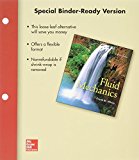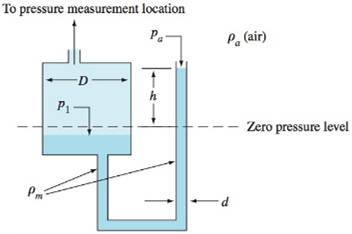
Concept explainers
(a)
The expression for gage pressure in the reservoir.
Answer to Problem 2.1CP
If the movement of the surface of the reservoir is considered, the expression for
Explanation of Solution
Given:

Concept Used:
Force acting on the panel is given by
Where,
Pressure
Where,
Calculation:
Let,
The volume of the liquid raised in the manometer open tube is equal to the volume of liquid lowered down in the reservoir.
Neglecting the effect of surface tension and the density of air, the pressure difference can be written as
Substituting the value of
Thus, the expression for
Conclusion:
The expression for
(b)
The expression for the gage pressure in the reservoir if the movement of the surface of the reservoir is neglected.
Answer to Problem 2.1CP
If the movement of the surface of the reservoir is neglected, the expression for
Explanation of Solution
Given:

Concept Used:
Force acting on the panel is given by
Where,
Pressure
Where,
Calculation:
Let,
The volume of the liquid raised in the manometer open tube is equal to the volume of liquid lowered down in the reservoir.
Neglecting the effect of surface tension and the density of air, the pressure difference can be written as
Substituting the value of
If the movement of the surface of the reservoir is neglected,
Thus, the expression for
Conclusion:
The expression for
(c)
The ratio of
Answer to Problem 2.1CP
The ratio of
Explanation of Solution
Given:

Concept Used:
Force acting on the panel is given by
Where,
Pressure
Where,
Calculation:
Let,
The volume of the liquid raised in the manometer open tube is equal to the volume of liquid lowered down in the reservoir.
Neglecting the effect of surface tension and the density of air, the pressure difference can be written as
Substituting the value of
In fact, the above expression is
If the movement of the surface of the reservoir is neglected,
It is clear from the above tow expressions, the values of
The percentage error is given by
If the error is less than or equal to
If the error is less than or equal to
Conclusion:
The ratio of
Want to see more full solutions like this?
Chapter 2 Solutions
Package: Loose Leaf For Fluid Mechanics With 1 Semester Connect Access Card
 Elements Of ElectromagneticsMechanical EngineeringISBN:9780190698614Author:Sadiku, Matthew N. O.Publisher:Oxford University Press
Elements Of ElectromagneticsMechanical EngineeringISBN:9780190698614Author:Sadiku, Matthew N. O.Publisher:Oxford University Press Mechanics of Materials (10th Edition)Mechanical EngineeringISBN:9780134319650Author:Russell C. HibbelerPublisher:PEARSON
Mechanics of Materials (10th Edition)Mechanical EngineeringISBN:9780134319650Author:Russell C. HibbelerPublisher:PEARSON Thermodynamics: An Engineering ApproachMechanical EngineeringISBN:9781259822674Author:Yunus A. Cengel Dr., Michael A. BolesPublisher:McGraw-Hill Education
Thermodynamics: An Engineering ApproachMechanical EngineeringISBN:9781259822674Author:Yunus A. Cengel Dr., Michael A. BolesPublisher:McGraw-Hill Education Control Systems EngineeringMechanical EngineeringISBN:9781118170519Author:Norman S. NisePublisher:WILEY
Control Systems EngineeringMechanical EngineeringISBN:9781118170519Author:Norman S. NisePublisher:WILEY Mechanics of Materials (MindTap Course List)Mechanical EngineeringISBN:9781337093347Author:Barry J. Goodno, James M. GerePublisher:Cengage Learning
Mechanics of Materials (MindTap Course List)Mechanical EngineeringISBN:9781337093347Author:Barry J. Goodno, James M. GerePublisher:Cengage Learning Engineering Mechanics: StaticsMechanical EngineeringISBN:9781118807330Author:James L. Meriam, L. G. Kraige, J. N. BoltonPublisher:WILEY
Engineering Mechanics: StaticsMechanical EngineeringISBN:9781118807330Author:James L. Meriam, L. G. Kraige, J. N. BoltonPublisher:WILEY





